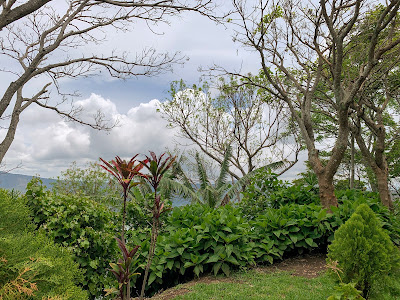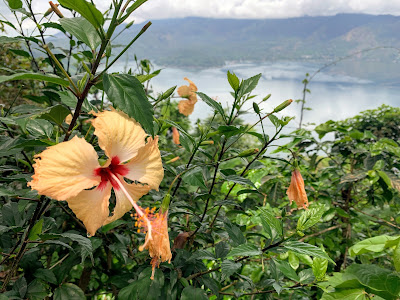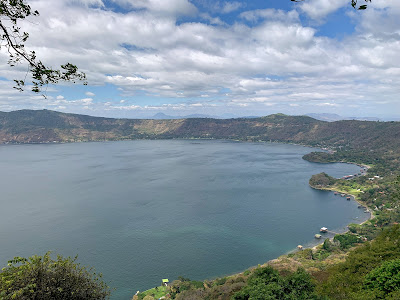Vacation Week: Coffee Stop above Lake Coatepeque
During the first part of May, we went on vacation - in El Salvador. My husband and I and another couple from our US neighborhood decided to take a life break and do the touristy thing. We traversed the country, from San Salvador to Auachupan to La Unión, driving along the coastal highway and enjoying plenty of good food and fun.
This is a thing the four of us do together in the US, so we know that we are compatible travelers who can live together, drive a distance together, and agree on food places. In the US we do a lot of exploring of new places. Our mutual goal for the vacation in El Salvador was to relax, so we chose a mix of experiences that were tested out by my husband and me and some which were a little more unknown. When traveling around in El Salvador, it is wise to use a guide for anything off the beaten path, to do your research, to enter neighborhoods with trusted folks and to confirm plans by phone shortly before you head out.
When the four of us travel, we follow the "what happens in Vegas, stays in Vegas" rule (i.e. no telling of the embarrassing or disaster stories to others, and yes, we have been to Vegas together). So, while we had a few hiccups in our plans (all of which we were able to overcome), I will stick to sharing sights and suggestions for those who might be interested in visiting some fun in person or who enjoy learning about some sites in El Salvador from afar.
 |
| Fields of sugar cane on the flat plain as we head toward the volcanoes in Santa Ana and Lake Coatepeque |
We set out on a cloudy morning and headed out west to the rim of the crater lake, Lago Coatepeque. This lake was formed by an enormous eruption that took place between 57,000 and 72,000 BCE. The water in the lake consists of rain water, run-off from the interior sides of the caldera, and springs. Lack of proper waste water management (especially due to recent increased development of restaurants and hotels along the lake shore) greatly threaten the health of the lake. Ecologists predict it could be a dead lake in 10 years if the municipal governments don't take radical action to enforce water protection laws. Many private villas within the watershed do not have authorized waste water systems. In an effort to help the lake recover and to protect it from further contamination, the Lake Coatepeque Foundation works with businesses and the local government to educate the public, survey gray and black water systems, recommend improvements to businesses and home owners, and monitor compliance.
 |
| Lakeshore development can be done with proper septic systems set back from the shore. This photo was taken by my friend Bob in February when we stopped for coffee on the lakeshore with a delegation. |
Our first vacation stop was above the lake at a restaurant we have frequented a few times with delegations. Restaurante Vista Lago is located on land farmed by the Asociación Cooperativa de Producción Agropecuaria Los Pinos (Cooperative Association of Agricultural Production Los Pinos). This cooperative, dedicated primarily to coffee production, formed in 1980 in the wake of agrarian reform movements. Beginning in 2009, the cooperative diversified its labors and now offers tourists the restaurant, garden hiking paths, cabins for overnight stays and tours of the lake area. The cooperative also has added vegetable and fruit gardens and tilapia production. They are committed to growing and producing coffee using ecological and just labor practices. We learned about his place from our long-time delegation drivers.
 |
| View of lake Coatepeque from Vista Lago Restaurant |
 |
| The grounds around the cabins are beautiful. |
 |
| On a cloudy day, the lake blends in a bit with the interior walls of the caldera, much of which is planted with coffee. |
 |
| I took this photo in February - blue sky and dry season. |
Next stop: Tazumal




Thanks again Linda! I so enjoy revisiting from time to time!
ReplyDelete